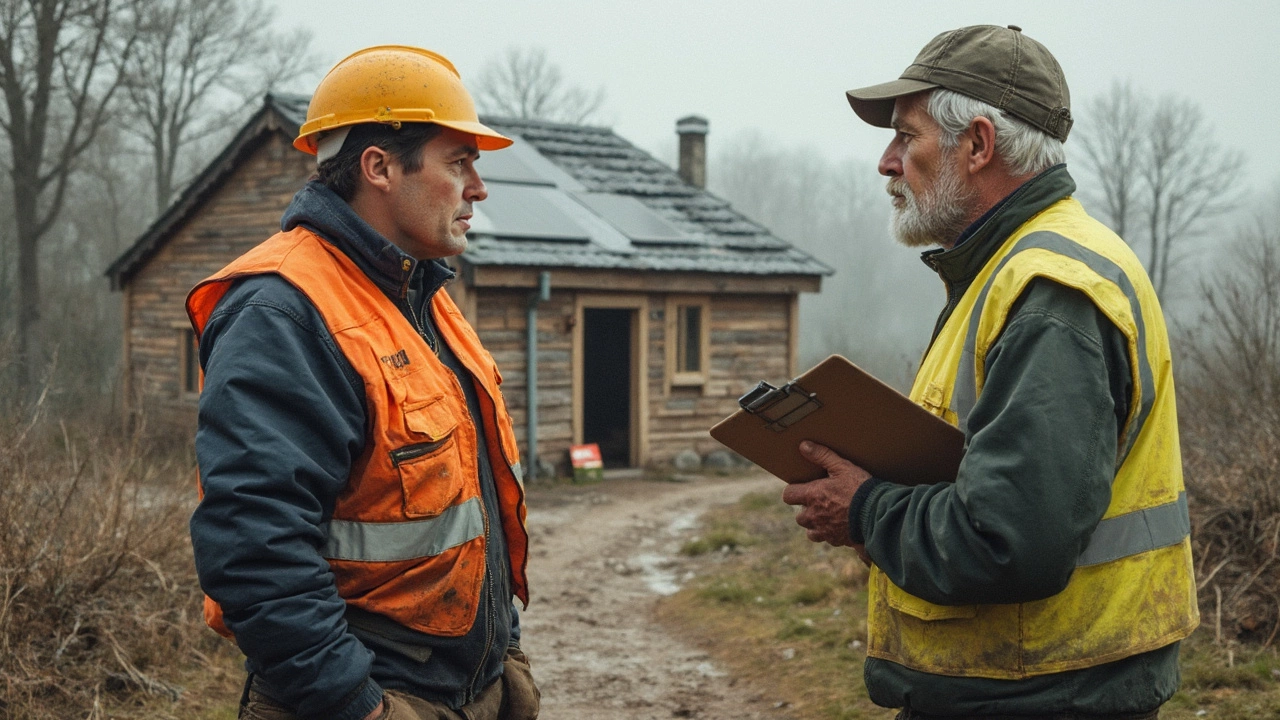If you start dreaming about building an eco-friendly cottage, you’ll quickly hit a few brick walls—sometimes literally. Building green isn’t as simple as just swapping regular cement for something sustainable or throwing solar panels on a roof. The first big thing? Where you put that house matters a ton. Not every plot is ready for eco-tech, and the best sites often cost more or come with awkward rules that force you to work around nature rather than bulldozing ahead.
Then there’s the reality that not all 'green' materials are easy to find, local, or even allowed in your region. Fancy straw bale insulation sounds awesome until you find out it’s basically illegal in some towns, or breaching code brings project-ending fines. Even when you get the right stuff, some sustainable choices don’t play nicely with local weather or common pests. Every choice, from wood treated with natural oils to recycled windows, has trade-offs you should know about before falling in love with that Pinterest board.
- Land and Location Challenges
- Material and Technology Hurdles
- Regulations, Codes, and Permits
- Cost and Lifestyle Trade-Offs
Land and Location Challenges
Picking the right spot for your eco-friendly home isn’t just about a pretty view. A lot comes down to the land itself. Some plots look promising until you dig deeper—in both senses. If you’re outside the city, you might run into problems getting utilities like water or clean energy, which can quickly bump up costs and headaches. Even getting basic road access can be a huge project if your land is off the beaten path.
Soil health is another biggie. Not every piece of land is ready to support things like natural wastewater systems. You might need soil testing to make sure yours drains well enough for things like rain gardens or composting toilets. Without the right kind of soil, you’re stuck either spending big for upgrades or scrapping some sustainable features altogether.
And don’t forget about local wildlife or protected plants. Some regions have strict rules about what you can clear or build, especially in wetlands or forests. You could face hefty fines if you mess with protected habitats. Always check local restrictions before you buy.
If you’re hoping to use solar or wind energy, you have to check your land’s exposure to sun or steady wind. Trees and hills can block both, so the most “green” lot on paper might not deliver the renewable energy you expected. Smart builders use apps or tools to measure sunlight hours and typical wind speed before making a decision.
Finally, watch out for zoning laws. Some towns block small homes or prevent off-grid systems. Even the dreamiest spot can turn into a paperwork nightmare if the local rules weren’t made for eco-cottages. Always look up these details first, or local councils could squash your plans before you start.
Material and Technology Hurdles
Shopping for truly eco-friendly materials means more than just grabbing something stamped with a green label. For starters, some of the most hyped low-impact materials—like bamboo flooring or rammed earth walls—aren’t always available at your local supply store. Even if you can find them, shipping them from halfway across the world kills their climate benefits. Locally sourced wood or stone is usually the better call, but it depends on what’s handy in your area.
Let’s talk insulation. Sheep’s wool and cellulose (basically recycled paper) both sound like perfect green picks, but they aren’t always up to code. In areas with humidity, you risk mold or extra pests if the material isn’t installed right. Straw bale homes are super energy efficient, but many towns flat-out ban them due to fire worries or lack of clear rules.
Now for the tech. Everyone pictures sprawling solar panels and fancy water recycling systems. Problem is, eco-friendly home tech isn’t one size fits all. Solar power needs direct sunlight for most of the day, so if your cottage will be in a shady forest, expect higher costs or less reliable energy. Heat pumps are impressive in mild climates but struggle during freezing winters or boiling summers unless you spend big on backup systems.
- Low-VOC paints and adhesives? Safer indoors but cost 20–50% more.
- Triple-glazed windows save energy but can double your window budget.
- LED lighting cuts electric bills, but not everyone enjoys the color or brightness.
Here’s a quick look at some challenges with key materials and systems:
| Material/System | Common Hurdle | Cost Range |
|---|---|---|
| Bamboo Flooring | High shipping emissions, pricey | $5–8/sq ft |
| Solar Panels | Needs high sun, tricky roof installs | $10,000–20,000 total |
| Straw Bale Walls | Not legal everywhere | $25–35/sq ft |
| Sheep's Wool Insulation | Pests, fire rules | $1.50–2.50/sq ft |
Even small tech like compost toilets or rainwater catchment systems can send you on a chase for local plumbers or installers who actually know how to work with something outside the norm. Be ready to do a ton of research, dig up suppliers, and double-check cross-country shipping isn’t eating away at your home’s green promise.

Regulations, Codes, and Permits
Here’s where most eco-friendly home projects run into their first real showdown: the rules. The building codes that say what you can and can’t do aren’t always set up for green thinking. The International Residential Code (IRC), which covers most of the U.S., gets updates every three years, but a lot of towns still use older versions that barely even mention solar panels, rainwater collection, or natural insulation like hempcrete.
If you want to put up a eco-friendly home that’s not stick-built with fiberglass and regular siding, brace yourself for paperwork. Earthships, straw bale cottages, and even simple composting toilets set off red flags for many local permitting offices. Want to put in a greywater system so your shower water waters the garden? You might need an engineer’s stamp, sometimes even an expensive consultant. According to a recent survey by Green Builder Media, 42% of people planning sustainable builds named permitting hassles as their #1 headache.
Regulations aren’t just about safety; some rules exist because nobody bothered to update them. I once heard an inspector say, “I’d love to approve this, but the code was written long before anyone thought of this stuff. My hands are tied.” Even old housing associations can kibosh a green roof or wind turbine on style grounds. As Steven Winter, a well-known green architect, put it:
"Codes often lag behind technology. It’s not that the ideas are bad—it’s just that the rules haven’t caught up."
What helps? Do your research before you fall in love with a blueprint. Ask your local building office these questions and take notes:
- What’s your version of the building code, and when was it updated?
- Are alternative materials like straw, hempcrete, or cob allowed?
- How do you regulate off-grid energy systems—solar, batteries, etc.?
- Is there a fast-track or extra fee for sustainable tech or rainwater systems?
- Can you see sample plans that got approved recently?
If you know what’s likely to get flagged, you can plan ahead or tweak your design. Sometimes working with an architect or builder who already knows the local rules can save months—or even keep your dream cottage alive when others might give up.
Cost and Lifestyle Trade-Offs
Building an eco-friendly home isn’t always cheaper upfront—let’s get that out of the way. Sustainable materials, like FSC-certified lumber or triple-glazed windows, often cost 20-40% more than standard stuff you find at big box stores. Then there’s the bump from specialized labor: not every local builder knows how to work with things like rammed earth or straw bales, so you might pay extra or have to wait for the right crew to be available.
Green tech can be another budget shock. Geothermal heating systems or rainwater collection setups sound great, but the install costs catch a lot of people off guard. For example, a full solar panel array for a rural cottage could run over $20,000 up front, even though you do save money (and the environment) in the long term. If you want battery backup, add a few more grand. Off-grid dreams? Budget for backup generators or a water well if you’re in a remote spot, because being fully self-reliant isn’t as low-cost as the brochures promise.
Your daily life in a sustainable cottage might feel a little different than in a regular house. Good insulation keeps heat in, but also means you might have to learn new habits—like using controlled ventilation instead of just popping open a window. Composting toilets and greywater systems need maintenance. You may have to wash clothes differently, use less water, or adapt to cooking on an induction stove if you’re trying to ditch fossil fuels. It’s not about suffering, but let’s be real: the lighter footprint usually comes with tweaks to your daily routines.
Before breaking ground, it helps to:
- List your must-haves vs. nice-to-haves
- Get true cost estimates for materials and labor in your area
- Talk to other homeowners who went green and ask what surprised them
- Budget for 10-15% more than expected to cover surprises and learning curves
Living green is awesome, but it’s not always instant savings and free time. Knowing what you’re signing up for, financially and lifestyle-wise, makes the whole build way less stressful—and way more rewarding.
